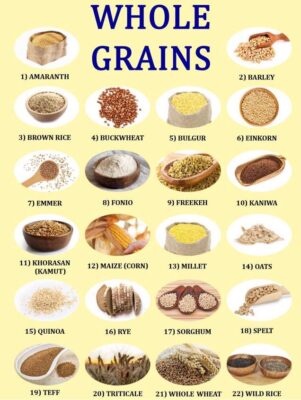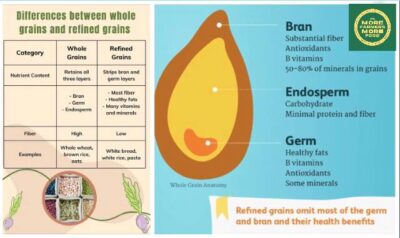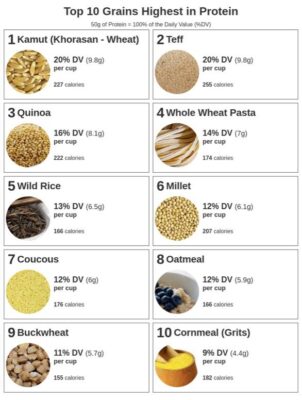Week 5 of More Farmers More Food looks at cereal farming.
In this Article...
We look at the difference between whole grains and refined grains with regard to health benefits.

Arable farms grow cereal crops. Wheat, barley and oats are the most common, with wheat being the most widely grown. England produces grain for a plethora of British food and drink products and has some of the highest crop yields in the world thanks to its maritime climate. The amount of crop from 1 hectare in the UK equates to that of 2 hectares elsewhere in the world. A hectare of wheat (approx size of a football pitch) produces an average of 7.5 tonnes of grain. That’s enough to make 11,500 loaves of bread. Every year the UK produces over 20 million tonnes of grain for our food. Cereals can be processed for high protein animal feeds, but whether these processed foods should be being eaten is now being questioned by some people and we’re seeing a return to a more natural grass/pasture-fed diet. Crops such as rapeseed create oil for cooking. The long-term effect of seed oils are now being researched and some would say they have an adverse effect on our bodies. Some people are returning to natural fats for cooking use.
The flour milling process has evolved from wheat being ground between two large stone wheels, to a vast range of milling machinery that are used in a modern industrial mill, which convert the wheat into flour. The practice centres around separating the three components of a wheat seed:
• the white endosperm
• the outer bran layers
• the wheat germ
to create a fine flour suited for today’s uses. It is found in a huge range of food products from bread, cakes, biscuits and breakfast cereals. The UK produces over 4 million tonnes of flour every year and every day the equivalent of 11 million loaves of bread are made. 85% of the wheat used is British.
Some people are returning to using ancient or heirloom grains. Whilst modern wheat is responsible for the vast majority of flour in the UK, there are bakers returning to the heirloom grains of yesteryear to create bread that’s a cut above the rest. Wheat has been with us since the dawn of civilisation, initially being collected in the wild before being cultivated for domestic use. As society became more advanced we started to cross-breed and hybridise different varieties to boost yields, improve flavour and make harvesting easier. Wheat went from being a wild grass to one of the most important crops in the world!
At the beginning of the 20th Century as populations grew, modern wheat was created in combination with new nitrogen-based fertilisers. This became resistant to pests and diseases and was made easier to process into flour. But as a result, these big industrial systems and processes are now having an adverse effect on our ecosystems. However, from the 1970’s we saw a rapidly growing movement to start growing and milling heirloom and ancient grains.
Whole grains are an important part of a balanced diet as they contain dietary fibre. Unlike refined grains which are often found in sugary processed foods, whole grains have not been stripped of three beneficial elements: the bran, the endosperm and germ. These 3 components are rich in vitamins, minerals, antioxidants and dietary fibre. We should be reducing our reliance on refined carbs and we can easily swap them out for 100% wholegrain versions.
Here are some of the healthiest whole grains:
•whole oats
•freekeh
•whole grain barley
•buckwheat
•bulgur
•quinoa
•wild rice
•millet
•amaranth
•farro
•teff
•whole wheat
•rye
Plus many more too…

Whole grains are healthy and nutritious as long as you are choosing them in their most natural state. As long as they have not been overly processed and stripped of all the nutrients they offer! Whole grains have all parts of the plant’s whole seed or the kernel in its natural form. Whole grains offer nutrients like iron and magnesium and help lower total cholesterol and inflammation levels. They also aid digestion. The fibre in whole grains helps to lower blood pressure and supports gut health.
The bran (the outer skin) contains fibre, B vitamins, copper, iron, magnesium, phosphorus, potassium, antioxidants and phytochemicals.
The germ (the part that grows into another plant) contains vitamin E, healthy fats and phytochemicals.
The endosperm (the middle and largest part) contains proteins and starchy carbohydrates.
You can eat whole grains in their whole forms or processed into foods like whole grain bread or pasta. These are far superior nutritionally compared to refined grains that are stripped of their layers. Consuming whole grains that contain macronutrients like protein and fibre and micronutrients offer health benefits such as reducing inflammation and contributing to a longer lifespan along with eating a balanced and healthy diet.

Fun fact of the day – Did you know that wheat can be turned into bioethanol for use in biofuels, which could power cars?



